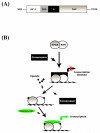Role of transcription factors in mediating post-ischemic cerebral inflammation and brain damage
- PMID: 17532542
- PMCID: PMC2040388
- DOI: 10.1016/j.neuint.2007.04.019
Role of transcription factors in mediating post-ischemic cerebral inflammation and brain damage
Abstract
Inflammation is a known precipitator of neuronal death after cerebral ischemia. The mechanisms that promote or curtail the start and spread of inflammation in brain are still being debated. By virtue of their capability to modulate gene expression, several transcription factors induced in the ischemic brain can modulate the post-ischemic inflammation. While the induction of transcription factors such as IRF1, NF-kappaB, ATF-2, STAT3, Egr1 and C/EBPbeta is thought to promote post-ischemic inflammation, activation of transcription factors such as HIF-1, CREB, c-fos, PPARalpha, PPARgamma and p53 is thought to prevent post-ischemic inflammation and neuronal damage. Of these, PPARgamma which is a ligand-activated transcription factor was recently shown to prevent inflammatory gene expression in several animal models CNS disorders. This review article discusses some of the molecular mechanisms of PPARgamma induction by its agonists following focal cerebral ischemia.
Figures

Similar articles
-
Decreased brain damage and curtailed inflammation in transcription factor CCAAT/enhancer binding protein beta knockout mice following transient focal cerebral ischemia.J Neurochem. 2006 Sep;98(6):1718-31. doi: 10.1111/j.1471-4159.2006.04056.x. Epub 2006 Aug 8. J Neurochem. 2006. PMID: 16899075
-
Post-ischemic brain damage: NF-kappaB dimer heterogeneity as a molecular determinant of neuron vulnerability.FEBS J. 2009 Jan;276(1):27-35. doi: 10.1111/j.1742-4658.2008.06767.x. FEBS J. 2009. PMID: 19087197 Review.
-
Neuroprotective effects of pioglitazone in a rat model of permanent focal cerebral ischemia are associated with peroxisome proliferator-activated receptor gamma-mediated suppression of nuclear factor-κB signaling pathway.Neuroscience. 2011 Mar 10;176:381-95. doi: 10.1016/j.neuroscience.2010.12.029. Epub 2010 Dec 24. Neuroscience. 2011. PMID: 21185913
-
Peroxisome proliferator-activated receptor-gamma agonists induce neuroprotection following transient focal ischemia in normotensive, normoglycemic as well as hypertensive and type-2 diabetic rodents.J Neurochem. 2007 Apr;101(1):41-56. doi: 10.1111/j.1471-4159.2006.04376.x. J Neurochem. 2007. PMID: 17394460
-
Modulation of neuro-inflammation and vascular response by oxidative stress following cerebral ischemia-reperfusion injury.Curr Med Chem. 2008;15(1):1-14. doi: 10.2174/092986708783330665. Curr Med Chem. 2008. PMID: 18220759 Review.
Cited by
-
Annexin A2 depletion exacerbates the intracerebral microhemorrhage induced by acute rickettsia and Ebola virus infections.PLoS Negl Trop Dis. 2020 Jul 20;14(7):e0007960. doi: 10.1371/journal.pntd.0007960. eCollection 2020 Jul. PLoS Negl Trop Dis. 2020. PMID: 32687500 Free PMC article.
-
Mitochondrial fission and fusion in secondary brain damage after CNS insults.J Cereb Blood Flow Metab. 2016 Dec;36(12):2022-2033. doi: 10.1177/0271678X16671528. Epub 2016 Sep 27. J Cereb Blood Flow Metab. 2016. PMID: 27677674 Free PMC article. Review.
-
A delta-secretase-truncated APP fragment activates CEBPB, mediating Alzheimer's disease pathologies.Brain. 2021 Jul 28;144(6):1833-1852. doi: 10.1093/brain/awab062. Brain. 2021. PMID: 33880508 Free PMC article.
-
Therapeutic modulation of JAK-STAT, mTOR, and PPAR-γ signaling in neurological dysfunctions.J Mol Med (Berl). 2023 Feb;101(1-2):9-49. doi: 10.1007/s00109-022-02272-6. Epub 2022 Dec 7. J Mol Med (Berl). 2023. PMID: 36478124 Review.
-
Mechanisms of tumor necrosis factor-alpha-induced interleukin-6 synthesis in glioma cells.J Neuroinflammation. 2010 Mar 6;7:16. doi: 10.1186/1742-2094-7-16. J Neuroinflammation. 2010. PMID: 20205746 Free PMC article.
References
-
- Barnes PJ, Adcock IM. Transcription factors and asthma. Eur. Respir. J. 1998;12:221–234. Review. - PubMed
-
- Barone FC, Feuerstein GZ. Inflammatory mediators and stroke: new opportunities for novel therapeutics. J. Cereb. Blood Flow Metab. 1999;19:819–834. - PubMed
-
- Barone FC, Schmidt DB, Hillegass LM. Reperfusion increases neutrophils and leukotriene B4 receptor binding in rat focal ischemia. Stroke. 1992;23:1337–1348. - PubMed
Publication types
MeSH terms
Substances
Grants and funding
LinkOut - more resources
Full Text Sources
Other Literature Sources
Research Materials
Miscellaneous

